Welcome to our free classical music site

Do you write about classical music? Are you a blogger? Want to team up with Classical Connect? Send us a message, let's talk!

Do you write about classical music? Are you a blogger? Want to team up with Classical Connect? Send us a message, let's talk!
April 20, 2014. Happy Easter to all!
Here, to celebrate, is one of Bach’s Easter cantatas, Christ lag in Todes Banden, BWV 4. Concentus musicus Wien is conducted by Nikolaus Harnoncourt.
The fresco, above, The Resurrection, is by Piero della Francesca and was painted around 1463-1465. Aldous Huxley called it “the greatest picture in the world.”Permalink
April 14, 2014. Ockeghem. Johannes Ockeghem was one of the greatest composers of the Franco-Flemish school, and, therefore, one of the greatest composers of the early Renaissance, as Burgundians dominated the European musical scene in the 15th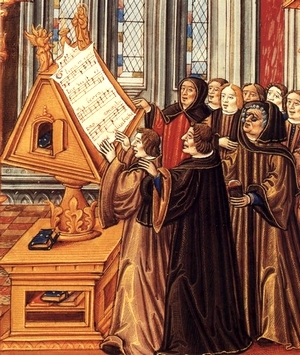 century. The date of Ockeghem’s birth is very much in doubt, some researchers suggest 1410, other – 1425. He was probably born in the town of Saint-Ghislain, not far from Mons, the capital of the county of Hainaut. Two famous composers, Gilles Binchois some years earlier and Orlando di Lasso a century later were born in Mons. It’s possible that Ockenghem studied with Binchois, and it’s even more probable that they met at the Burgundian court later on. In 1443 Ockeghem was a chorister in Antwerp, and between 1446 and 1448 served at the court of Charles I, Duke of Bourbon. The dukes were of an old noble family that would eventually rule all of France (king Louis XIV was a Bourbon), but at the time of Ockeghem the French kings came from the House of Valois. Ockeghem would serve them as well: he moved to Paris around 1452 and was hired as a singer at the court of King Charles VII (according to contemporaries, Ockeghem had a beautiful bass voice). Several years later he was given the title of Maistre de chapelle de chant du roy. He also became a canon of the cathedral of Notre Dame de Paris. In 1460 Gilles Binchois died in Soignies and Ockeghem wrote a “Déploration” (Lamentation) on his death. You can listen to it hear. The Laudantes Consort is led by Guy Janssens.
century. The date of Ockeghem’s birth is very much in doubt, some researchers suggest 1410, other – 1425. He was probably born in the town of Saint-Ghislain, not far from Mons, the capital of the county of Hainaut. Two famous composers, Gilles Binchois some years earlier and Orlando di Lasso a century later were born in Mons. It’s possible that Ockenghem studied with Binchois, and it’s even more probable that they met at the Burgundian court later on. In 1443 Ockeghem was a chorister in Antwerp, and between 1446 and 1448 served at the court of Charles I, Duke of Bourbon. The dukes were of an old noble family that would eventually rule all of France (king Louis XIV was a Bourbon), but at the time of Ockeghem the French kings came from the House of Valois. Ockeghem would serve them as well: he moved to Paris around 1452 and was hired as a singer at the court of King Charles VII (according to contemporaries, Ockeghem had a beautiful bass voice). Several years later he was given the title of Maistre de chapelle de chant du roy. He also became a canon of the cathedral of Notre Dame de Paris. In 1460 Gilles Binchois died in Soignies and Ockeghem wrote a “Déploration” (Lamentation) on his death. You can listen to it hear. The Laudantes Consort is led by Guy Janssens.
After the death of Charles in 1461, Ockeghem continued at the court of his son, King Louis XI. By 1475 the One Hundred Year’s War was over. Louis XI signed a treaty with the English and went to battle his other sworn enemy, the Burgundians. Two years later Charles the Bold, the Duke of Burgundy, was killed in a battle, and Louis XI took possession of many of the Duchy’s territories, including Burgundy itself. Lois XI died in 1483; Ockeghem continued at the court of Charles VIII, but eventually left Paris. He spent some time in Bruges and then went to Tours, where he held a prestigious position of the treasurer of the St.-Martin Cathedral. He died in Tours in 1497. Many “laments” were composed at his death, just as he did when Binchois died. The most famous of these funeral chansons was written by Josquin des Prez. You can listen to it hear, in the performance by Laudantes Consort with Guy Janssens.
Compared to his predecessors, Guillaume Dufay, John Dunstaple or Gilles Binchois, Ockeghem’s textures seem to be richer and more sonorous. He wasn’t a very prolific composer: his extant output consists of 14 masses, 10 motets, and several chansons. Here’s Kyrie from his L'homme armé Mass. It’s preceded by the famous tune itself, which is later user throughout the mass, usually in the tenor part and slow development, so it’s not easy to hear it directly. Oxford Camerata is lead by Jeremy Summerly. And hear’s an amazing motet Deo gratias, for four nine-part choruses – thirty-six parts altogether, in a virtuoso performance by the Huelgas Ensemble. It’s lead by Paul van Nevel.
The anonymous picture above is often considered a portrait of Ockeghem with members of the choir. He’s the one wearing the glasses!
PermalinkApril 7, 2014. Rachmaninov and Stradella. We missed the birthday of Sergei Rachmaninov, and probably by more than one week: according to the new calendar, he was born on April 1st of 1873 - but back then Russia was still using the Julian calendar, so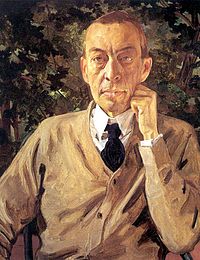 contemporary documents state that Rachmaninov was born on March 20th. As talented as he was anachronistic, he wrote 19th century music well into the 20th. But do we really mind if so much of it was so good? Rachmaninov’s life was divided in two by the October revolution: he left Russia at the end of 1917 for a concert tour and never returned. On November 1, 1918, after a series of concerts in Scandinavia, he and his family boarded a ship to New York. He lived in the United States for the rest of his life (Rachmaninov died in 1943 in his home in Beverly Hills). In this second part of his life, he concretized a lot (he was, after all, one of the greatest pianist of the 20th century) and composed rather little. In 26 years he wrote just five major compositions: Piano Concerto no. 4, Variations on a Theme of Corelli, Rhapsody on a Theme of Paganini for piano and orchestra, Symphony no. 3 and Symphonic Dances. The Russian half of his life was much more productive: three piano concertos, two symphonies and the symphonic poem Isle of the Dead, several operas (none of them very successful, except probably Aleko, which he wrote as a graduation work at the Moscow Conservatory) and a large number of piano pieces. The Piano Concerto no. 3 was written in the summer of 1909 during his stay at the much-loved family estate of Ivanovka (it was lost during the Revolution). One of Rachmaninov’s masterpieces, it’s technically one of the most difficult compositions in the piano repertoire. Rachmaninov brought it to his tour of the United States, and premiered the work in New York on November 28, 1909. Walter Damrosch conducted the New York Symphony orchestra. Several weeks later Rachmaninov played it again, this time with Gustav Mahler conducting. We’ll hear it in the 1955 performance by Emil Gilels, one of the greatest interpreters of this concerto. André Cluytens is conducting Orchestre de la Société des Concerts du Conservatoire. The portrait of Rachmaninov, above, was painted by the Russian artist Konstantin Somov in 1925.
contemporary documents state that Rachmaninov was born on March 20th. As talented as he was anachronistic, he wrote 19th century music well into the 20th. But do we really mind if so much of it was so good? Rachmaninov’s life was divided in two by the October revolution: he left Russia at the end of 1917 for a concert tour and never returned. On November 1, 1918, after a series of concerts in Scandinavia, he and his family boarded a ship to New York. He lived in the United States for the rest of his life (Rachmaninov died in 1943 in his home in Beverly Hills). In this second part of his life, he concretized a lot (he was, after all, one of the greatest pianist of the 20th century) and composed rather little. In 26 years he wrote just five major compositions: Piano Concerto no. 4, Variations on a Theme of Corelli, Rhapsody on a Theme of Paganini for piano and orchestra, Symphony no. 3 and Symphonic Dances. The Russian half of his life was much more productive: three piano concertos, two symphonies and the symphonic poem Isle of the Dead, several operas (none of them very successful, except probably Aleko, which he wrote as a graduation work at the Moscow Conservatory) and a large number of piano pieces. The Piano Concerto no. 3 was written in the summer of 1909 during his stay at the much-loved family estate of Ivanovka (it was lost during the Revolution). One of Rachmaninov’s masterpieces, it’s technically one of the most difficult compositions in the piano repertoire. Rachmaninov brought it to his tour of the United States, and premiered the work in New York on November 28, 1909. Walter Damrosch conducted the New York Symphony orchestra. Several weeks later Rachmaninov played it again, this time with Gustav Mahler conducting. We’ll hear it in the 1955 performance by Emil Gilels, one of the greatest interpreters of this concerto. André Cluytens is conducting Orchestre de la Société des Concerts du Conservatoire. The portrait of Rachmaninov, above, was painted by the Russian artist Konstantin Somov in 1925.
The Italian Baroque composer Alessandro Stradella was born on April 3rd, 1639. The legends surrounding his life are spectacular, even if we cannot vouch for their veracity. He was of noble descent, probably a Tuscan. In 1669 he moved to Rome, where Queen Cristina of Sweden became his benefactor (later she would offer patronage to Arcangelo Corelli, Alessandro Scarlatti and many other musicians).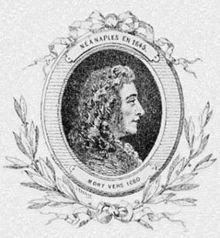 He attempted to embezzle money from the Church, had multiple affairs and eventually had to leave Rome. He went to Venice where Doge Alvise Contarini hired him as a music tutor to his mistress, Agnese Van Uffele. Uffele and Stradella fell in love and fled to Turin. Contarini sent two assassins after Stradella; they found and attacked him but Stradella survived. He then fled to Genoa where he continued composing and cuckolding local nobility. He met his end at the hands of yet another pair of assassins, this time craftier ones: they stabbed him to death in the center of Genoa, on Piazza Banchi. Stradella was 42. The murder was never solved but it was rumored that a local nobleman hired the killers. While engaged in all these shenanigans, Stradella also found time to compose music: he wrote almost 300 compositions, operas, oratorios, sonatas and other incidental pieces. His “sonatas” for solo instruments and a small orchestras became precursors of concerto grosso, later perfected by Corelli. Here is one of such sonatas, Sonata di viole. It’s performed by Orchestra Barocca della Civica Scuola di Musica di Milano, Enrico Gatti conducting.Permalink
He attempted to embezzle money from the Church, had multiple affairs and eventually had to leave Rome. He went to Venice where Doge Alvise Contarini hired him as a music tutor to his mistress, Agnese Van Uffele. Uffele and Stradella fell in love and fled to Turin. Contarini sent two assassins after Stradella; they found and attacked him but Stradella survived. He then fled to Genoa where he continued composing and cuckolding local nobility. He met his end at the hands of yet another pair of assassins, this time craftier ones: they stabbed him to death in the center of Genoa, on Piazza Banchi. Stradella was 42. The murder was never solved but it was rumored that a local nobleman hired the killers. While engaged in all these shenanigans, Stradella also found time to compose music: he wrote almost 300 compositions, operas, oratorios, sonatas and other incidental pieces. His “sonatas” for solo instruments and a small orchestras became precursors of concerto grosso, later perfected by Corelli. Here is one of such sonatas, Sonata di viole. It’s performed by Orchestra Barocca della Civica Scuola di Musica di Milano, Enrico Gatti conducting.Permalink
March 31, 2014. Haydn and Rachmaninov. The great Austrian composer Franz Joseph Haydn was born on this day in 1732. All musicians of the time needed patrons, and the main ones in Haydn’s life, princes Paul Anton and Nikolaus Esterházy, were exceptional. The Esterházys were an old Hungarian noble family who, through their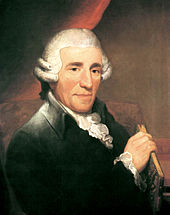 loyal service to the Habsburg emperors and opportune marriages, acquired land and wealth comparable to that of their sovereigns. They had several residences; the main was Schloss Esterházy in Eisenstadt, Austria, and that’s were Haydn spent the first years of his employ. One of the palace’s rooms served as a concert hall. Today it’s called Haydnsaal and is considered acoustically one of the finest concert halls in the world. The second residence, the magnificent Esterháza, was founded by Prince Nikolaus in 1762 and not completed till 1784. It cost 13 million gulden to construct (to compare, Haydn’s initial annual salary was 400 gulden). The palace had 124 rooms and two theaters, one for the opera (it was inaugurated with the performance of Haydn’s opera Lo Speciale) and one used as a marionettes theater. The Esterházys usually stayed there during the summers and from 1766 to 1790 Haydn had a separate four-room apartment in the servant’s quarters of the palace.
loyal service to the Habsburg emperors and opportune marriages, acquired land and wealth comparable to that of their sovereigns. They had several residences; the main was Schloss Esterházy in Eisenstadt, Austria, and that’s were Haydn spent the first years of his employ. One of the palace’s rooms served as a concert hall. Today it’s called Haydnsaal and is considered acoustically one of the finest concert halls in the world. The second residence, the magnificent Esterháza, was founded by Prince Nikolaus in 1762 and not completed till 1784. It cost 13 million gulden to construct (to compare, Haydn’s initial annual salary was 400 gulden). The palace had 124 rooms and two theaters, one for the opera (it was inaugurated with the performance of Haydn’s opera Lo Speciale) and one used as a marionettes theater. The Esterházys usually stayed there during the summers and from 1766 to 1790 Haydn had a separate four-room apartment in the servant’s quarters of the palace.
Haydn was hired by Prince Paul Anton in 1761 as a Vice-Kapellmeister: formally the title of Kapellmeister belonged to Gregor Werner, a minor composer, but from the start Haydn took over most of his duties. The prince was an amateur musician (as well as a Field Marshal); after appointing Haydn he went on to hire a number of virtuoso musicians. That greatly improved the quality of his private orchestra, which Haydn much appreciated. Paul Anton died one year later, just 51 years old, and his younger brother Nikolaus, who inherited the title of the prince, became the head of the family. Like Paul Anton, Nikolaus was very musical: he played cello, viola da gamba, and baryton, a large string instrument somewhat resembling bass viola, which could be played with a bow or plucked. It practically disappeared since the end of the 18th century, but Haydn wrote a large number of pieces for baryton to entertain Nikolaus, especially after a reprimand from the prince who commanded him to write more music for this instrument (many baryton trios survive but are rarely played today). Nikolaus valued Haydn very highly: after Werner’s death in 1766 he promoted him to full Kapellmeister, paid him well, and kept Luigia Polzelli, a second-rate soprano, on the payroll after learning that she is Haydn’s mistress.
From 1762 to 1790, the year of Nikolaus’s death, Haydn wrote a large number of string quartet and more than 60 symphonies. His orchestra was small, but the musicians were good (the prince paid well). Importantly, it was fully at Haydn’s disposal, so he could rehears and experiment at will. One of the symphonies, no. 45, became known as "Farewell." It was composed during the long summer residence at the Esterháza in 1772. Musician’s families stayed back in Eisenstadt, so musicians were getting lonely and wanted to go home. Haydn was famous for his sense of humor which he could express in musical terms, and in his new symphony he made a veiled suggestion that it’s time for them to go. Here's how it was done: in the last part of the final movement, Adagio, musicians in different sections are given a little solo to play. When it’s over, they snuff out the candle illuminating the music stand, and leave the stage. Other musicians follow them. In the end, only two violin players remain on the dark stage (in the original performance one of them was Haydn himself). Apparently, Nikolaus got the hint: the very next day the court moved back to Schloss Esterházy. You can hear the Farewell symphony in the performance by the Academy of Ancient Music, Christopher Hogwood conducting.
Sergei Rachmaninov was born on 20th of March old style, or April 1st, new style, of 1873. We’ll commemorate his birthday next week. Permalink
Mach 24, 2014. Bartók and d’Indy. Béla Bartók, one of the greatest composers of the 20th century, was born on March 25th of 1881. Last year we celebrated him with one of his last compositions, the Concerto For Orchestra, which he wrote in the US in 1943 and revised the year of his death, 1945. The last years of Bartók’s life were difficult: his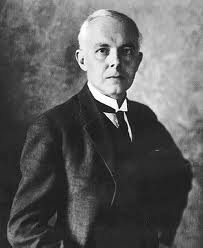 health was failing, he couldn’t adjust to the life in a foreign country, and his family was in financial dire straits. Today we’ll turn to a much brighter period in his life, from the late 1920s to the late ‘30s, when his art had reached its maturity and he produced a number of masterpieces. Much of Bartók’s music is intimately related to his activities as an ethnomusicologist. Together with Zoltan Kodály he collected a vast number of authentic folk melodies, not just Hungarian, but also Romanian, Slovakian, and Bulgarian. He even went to Algeria and Turkey to study the folk music of those countries. Bartók assimilated many of the tunes and tempos of old melodies into his own music, producing highly original and sophisticated pieces. During this period he wrote several String quartets, two Piano concertos, a composition for chorus and orchestra called Cantata Profana, a number of vocal, violin and orchestral pieces based directly on folk tunes, and one of his best-known compositions, Music for Strings, Percussion and Celesta. It’s scored for an unusual set of instruments: the percussions include a xylophone, different drums, and a tam-tam. There’s also a piano, which is used more or less as a percussion instrument. And of course, such a prominent use of celesta, which looks like an upright piano but produces the sound when the hammers strike pieces of metal, is a rarity (it’s probably best known from the Dance of the Sugar Plum Fairy in Tchaikovsky’s ballet The Nutcracker, and Mahler used it broadly in his symphony, no. 6). You can hear Music in the performance by the Philadelphia Orchestra. The conductor is a fellow Hungarian, Eugene Ormandy (Ormandy, famous for his long and productive tenure in Philadelphia, was born in Budapest in 1899 and moved to the US in 1931).
health was failing, he couldn’t adjust to the life in a foreign country, and his family was in financial dire straits. Today we’ll turn to a much brighter period in his life, from the late 1920s to the late ‘30s, when his art had reached its maturity and he produced a number of masterpieces. Much of Bartók’s music is intimately related to his activities as an ethnomusicologist. Together with Zoltan Kodály he collected a vast number of authentic folk melodies, not just Hungarian, but also Romanian, Slovakian, and Bulgarian. He even went to Algeria and Turkey to study the folk music of those countries. Bartók assimilated many of the tunes and tempos of old melodies into his own music, producing highly original and sophisticated pieces. During this period he wrote several String quartets, two Piano concertos, a composition for chorus and orchestra called Cantata Profana, a number of vocal, violin and orchestral pieces based directly on folk tunes, and one of his best-known compositions, Music for Strings, Percussion and Celesta. It’s scored for an unusual set of instruments: the percussions include a xylophone, different drums, and a tam-tam. There’s also a piano, which is used more or less as a percussion instrument. And of course, such a prominent use of celesta, which looks like an upright piano but produces the sound when the hammers strike pieces of metal, is a rarity (it’s probably best known from the Dance of the Sugar Plum Fairy in Tchaikovsky’s ballet The Nutcracker, and Mahler used it broadly in his symphony, no. 6). You can hear Music in the performance by the Philadelphia Orchestra. The conductor is a fellow Hungarian, Eugene Ormandy (Ormandy, famous for his long and productive tenure in Philadelphia, was born in Budapest in 1899 and moved to the US in 1931).
The French composer Vincent d'Indy was born in Paris on March 27, 1851. The d’Indys were an aristocratic family from Ardèche, and carried the title of counts. Vincent started piano lessons at an early age (his grandmother was his first teacher). Later he studied at the Paris Conservatory with Cesar Franck. He was critical of the teaching methods at the Conservatory, and in 1894 became one of the founders of a private music school called Schola Cantorum de Paris. The Schola became a very important French musical institution. Among his students there were Isaac Albéniz, Joseph Canteloube, Erik Satie, Arthur Honegger, Darius Milhaud and many other prominent musicians. Later in the 20th century Olivier Messiaen and Darius Milhaud taught at the school. Influenced by Wagner, Berlioz and his teacher, Franck, d’Indy was a very conservative composer. He lived to 1931, but none of developments in modern music, not even Impressionism, ever affected he work (he did conduct a number of works by Debussy, though). In addition to composing and teaching, d’Indy did much to revive some of the forgotten works of Palestrina, Monteverdi and the forgotten operas of Vivaldi. One of his more popular compositions is the poem Symphony on a French Mountain Air for piano and symphony orchestra. You can listen to it here, in the 1958 performance by the same Philadelphia orchestra under the baton of Eugene Ormandy. The piano soloist is Robert Casadesus, a major French pianist of the 20th century, and one of the greatest interpreters of the music of Ravel and Debussy.
PermalinkMarch 17, 2014. Bach. Johann Sebastian Bach was born on March 21th, 1685 (but see the note below) in Eisenach, a small town in what is now the central German state of Thuringia, but back then – the ducal seat of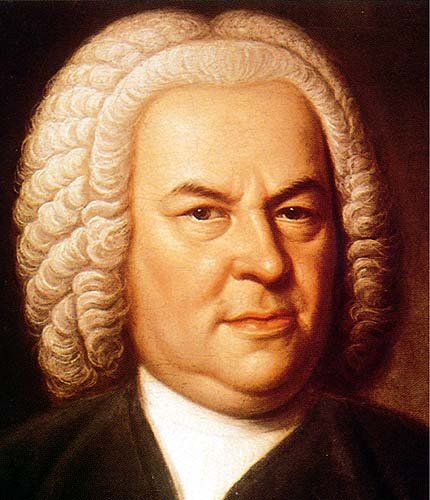 the house of Saxe-Eisenach. After working in Weimar for nine years and then serving at the court of Prince Leopold of Anhalt-Köthen for the following six (1717 through 1723), Bach received several prestigious positions in Leipzig. He was appointed the cantor of the Tomasschule, the school of the St. Thomas church, where he was to serve as the choir director. He was also made the music director of two other important churches in the city, St. Nicholas church (Nikolaikirche) and Paulinerkirche, the University church. His responsibilities included teaching music to the students at the school (the choirs of the main churches in Leipzig were formed from the best students of Tomasschule) and composing music for the three main churches. His most important assignment was to provide music for Sunday services. Every Sunday he was supposed to conduct a cantata, and he composed most of them himself. Additional cantatas were composed for holidays. Fortunately, during the Advent and Lent music was not performed, which gave Bach a respite. Cantatas were collected in annual cycles; in Bach’s obituary five such cycles are mentioned, of these three still exist and two were lost. While in Leipzig, Bach wrote more than 300 cantatas, of which more than 200 survive.
the house of Saxe-Eisenach. After working in Weimar for nine years and then serving at the court of Prince Leopold of Anhalt-Köthen for the following six (1717 through 1723), Bach received several prestigious positions in Leipzig. He was appointed the cantor of the Tomasschule, the school of the St. Thomas church, where he was to serve as the choir director. He was also made the music director of two other important churches in the city, St. Nicholas church (Nikolaikirche) and Paulinerkirche, the University church. His responsibilities included teaching music to the students at the school (the choirs of the main churches in Leipzig were formed from the best students of Tomasschule) and composing music for the three main churches. His most important assignment was to provide music for Sunday services. Every Sunday he was supposed to conduct a cantata, and he composed most of them himself. Additional cantatas were composed for holidays. Fortunately, during the Advent and Lent music was not performed, which gave Bach a respite. Cantatas were collected in annual cycles; in Bach’s obituary five such cycles are mentioned, of these three still exist and two were lost. While in Leipzig, Bach wrote more than 300 cantatas, of which more than 200 survive.
Despite this astonishing workload, he found time early in 1724 to create one of his major masterpieces, a sacred oratorio The St. John Passion. The Passion was composed for the Good Friday evening service. The basis of the text comes from the two chapters, 18 and 19, of the Gospel According to St. John, in Martin Luther’s translation. It was set in two parts. Part I starts with the Betrayal and Capture of Jesus, following with Peter’s Denial. Part II continues with Interrogation and Flagellation, then Condemnation and Crucifixion, followed by The Death of Jesus, and, finally, The Burial. The Evangelist, sung by a tenor, directly follows the words of the Gospel, narrating the text in recitative. The texts of the chorals come from the 16th and 17th century German hymnals. The Passion is also interspersed with arias for an alto (sometimes sung by a countertenor), a tenor, a soprano, and a bass. These voices represent the characters of the Gospel, such as Jesus himself, Apostle Peter, Pilate, and minor characters. They also sing for the people of Israel and the congregation.
Bach intended the Passion to be performed in the Thomaskirche, but at the last moment it was moved to St. Nicolas church. The harpsichord had to be repaired and additional room created for the choir, but that was done in time. The council sent out the flyers announcing the change of venue. Bach’s original orchestration was intimate: strings, basso continuo, flutes, oboes, and probably lute, viola d’amore and viola da gamba. In the 20th century a “romantic” tradition developed, with a much larger orchestra and richer sound. Lately, though, the process has reversed to something more resembling Bach’s original intentions. We’ll hear one such interpretation: Part I of The St. John Passion is performed by Concentus Musicus Wien, one of the earlier period-instrument ensembles, with the Arnold Schoenberg Choir, Nikolaus Harnoncourt conducting. It runs about 35 minutes.
A note on the dates: in 1685, when Bach was born, all German principalities were still using the Julian calendar, even though Italy and some other Catholic countries had converted to the new calendar, following the bull of Pope Gregory, in 1582 (therefore called Gregorian). German states didn’t adopt the modern calendar till 1700. By the time Bach was born, the difference between the Julian and Gregorian calendars (old and new styles) amounted to 10 days. That’s why some sources put Bach’s birthday on March 31, 1685.Permalink